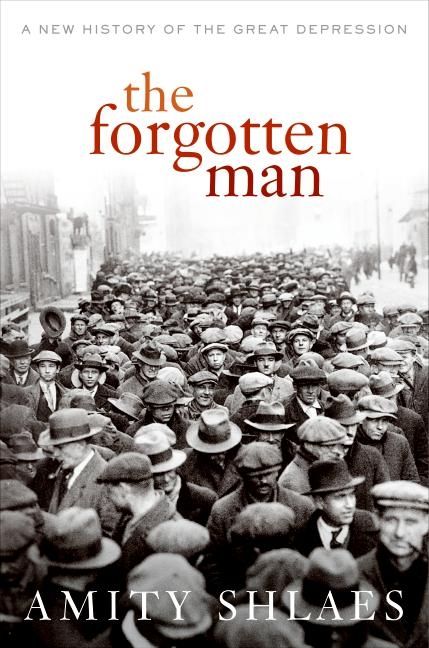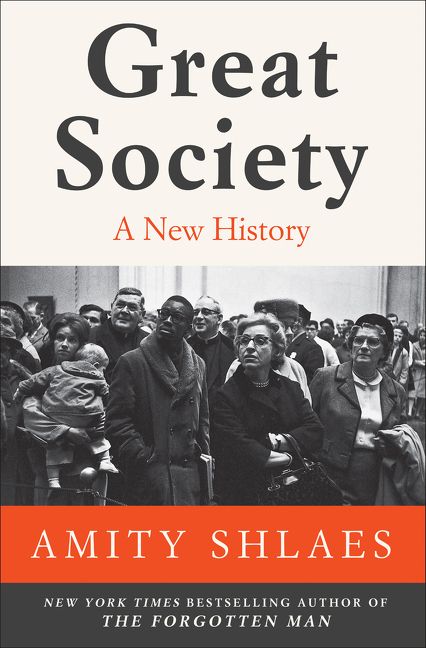The True Engine of Economic Recovery

A Conversation with Amity Shlaes
In recent months, you’ve likely heard many comparisons between the current crisis and the Great Depression of the 1930s. Amity Shlaes, a New York Times bestselling author and leading economic commentator, has written extensively about that era—so we asked her if the comparison is warranted.
In this discussion with Texas CEO Magazine owner Joel Trammell, Shlaes talks about the parallels between the current moment, the 1930s, and the Great Society of the 1960s, which is the topic of her latest book, Great Society: A New History. What might these turbulent passages of American history tell us about now? As it turns out, one lesson is clear: The driver of economic recovery is unlikely to be top-down planning policy, no matter how magnanimous its intentions may be.
Joel Trammell: In The Forgotten Man, you chronicled many of the failed government interventions of the 1930s. Now you’ve written a follow-up that takes on the Great Society of the 1960s, another era when the federal government attempted to correct problems in the society. Can you tell us about your background and what interests you in these topics?
Amity Shlaes: I’m interested in how economies work. I am a humanist by training, but my adult life has been a study of economies—what makes them grow and what makes them flounder. Over and over again, I’ve found that the way a country’s economy is set up explains a great deal about that country. If you’re trying to figure out why a country is the way it is, the economy will often tell you more than the religion or the culture or the history.
I got my start looking at politics and policy—that is, writing articles and journalism regarding politics, much of it on the topic of communist East Europe. I saw the great truth about communism: the economics doesn’t work. In the 1990s, I had the honor to sit on the editorial board of the Wall Street Journal, and it was in that role that I came to interview Governor Bush when he was thinking of running for president back in the day. I’d later work for him for a bit in Dallas at the George W. Bush Presidential Center.
For ten years, I served as a columnist, first at the Financial Times and Bloomberg. All the while, I was writing books. Eventually, the books took over. In the latter part of my life I’ve also become a nonprofit person. I now lead a nonprofit whose work is conveying the legacy of a president who was principally economic, Calvin Coolidge. That is the Calvin Coolidge Presidential Foundation.
Trammell: We’re hearing the word depression thrown around a lot these past few months. Obviously, there’s no clear definition of a depression, but do you see any parallels between where we are now and what this country went through in the 1930s? We’ve lost tens of millions of jobs at this point.
Shlaes: Well, the obvious parallel is the high unemployment. But a single high jobs number does not a depression make. The reason we remember the Great Depression was because it lasted 10 years, not because we had a bad job number in one or two snapshots in time. During the Great Depression, we had double-digit unemployment for 10 years. We’ve had high unemployment at other points in the United States’ history where we did not see a sustained depression follow that appalling data point. An example would be in the early 1920s, when unemployment went over 15 percent—and then went away. It was a more like a panic, not a great depression.
What makes a depression a depression is a series of poor policy decisions. Even if you have a deflationary spiral, where banks fail and money evaporates, you’re unlikely to see 10 years of double-digit unemployment unless, as we saw in the 1930s, you follow that spiral with a lot of bad fiscal and regulatory policy. In other words, poor employment policy, which discourages work, wasteful spending policy, intrusive efforts to reshape business by government. In the 1930s, there was a global decision to turn against markets and toward government and regulation. Government, whether “socialist” or just “kindly,” was where the salvation was expected to come from. And that shift toward government really was quite a deterrent to business, even in the United States. Recovery from the Great Depression didn’t come for many years. The stock market did not return to its 1929 level into the 1950s. We can study why that is and try not to offer up the same bad policies again.
Trammell: Can you explain some of the measures that kept recovery away back then?
Shlaes: Sure. For one, we pushed labor prices way up in the 1930s. If you look at a chart of labor costs in the United States in the 20th century, you’ll see something really perverse, which is that during the Great Depression, labor prices were really high. Why was that? How can we make employing people more expensive when businesses are struggling?
Part of the reason for that was strong labor law. The Wagner Act, which is much stronger than our current labor law, put upward pressure on wages, and employers had to pay a lot. They compensated and rehired fewer people. Today they would move a factory to Texas! But this was before the Taft-Hartley law gave us the “right to work” principle. Laws like the Wagner Act are a key reason the 1930s were so bad. In fact, the labor price was even higher than they knew because they weren’t accustomed to deflation. Businesses set a labor price—or agreed to one pressed on them by unions– without realizing that the money they committed to paying would cost them more when they had to pay it.
We also introduced weird policy at that time that tried to manage agriculture. We helped the farmer in some ways, but in other ways we hurt the farmer. The Agricultural Adjustment Act of 1933 encouraged farmers to destroy their crops so prices would go up. There are some wonderful stories about how Lyndon Johnson as a young man working for the New Deal had to teach farmers how to destroy their crops. The mules didn’t want to step all over the crops; they had been trained not to step on the plants, so it really upset the animals to stomp all over them.
It’s still an open question whether we managed farming right through the creation of the Agricultural Adjustment Administration that we had for a while. A lot of Texans would say it didn’t help their kind of farm; others would say it was good. Either way, it was a massive intervention. What is clearer is that the corollary agency for industry, the National Recovery Administration, killed businesses by overregulating them on the basis of spurious principles.
Generally speaking, government intervention in the 1930s did not create long-term, serious economic growth. Once in a while, New Deal intervention would rescue someone who didn’t have food, but we should separate humanitarian action from economic action. Humanitarian action can always be warranted and it’s not that expensive. But pretending that an intervention is economically logical just because it’s humanitarian can be dangerous. When government helps one person, its often end up hurting someone else. That other person is the forgotten man of the title of my book. That’s the big problem.

Trammell: We’re certainly seeing lots of those interventions right now.
Shlaes: We are. In all states, the administration is giving businesses money to stay open. That’s nice, but that money comes from somewhere, right? Eventually we’ll have to pay for that through taxes or inflation. Authorities are also ordering some businesses closed that don’t even need to close. The government is a poor manager of economies. That’s what the 1930s show, and if we forgot, we are seeing it again now.
Trammell: I think most business people would strongly agree that the more the government gets engaged in the business side of things, picking winners and losers, the worse they do.
Shlaes: Another thing is that stimuli have a long record of not doing what they’re supposed to. People don’t always spend their stimulus money like they’re supposed to. [The economist] Joel Slemrod has studied this extensively.
There are also echoes of what’s happening recalling the 1960s Great Society, which my most recent book is about. Some of the efforts now are very similar efforts to the efforts then, when government tried to help people economically by creating jobs through the poverty program. It was a Texas governor, John Connally who pushed back on many of Great Society measures because he felt that Texans weren’t behind them. He told Johnson’s chief of staff that people in Texas thought the War on Poverty was “a big boondog.” You can hear him say it. Connally was a colorful guy. Even Lyndon Johnson was scared of him. He was a real bully—and a real kind of angel, because he had been in the car with President Kennedy at the assassination. In any case, he was one of those people you couldn’t challenge.
Connally didn’t like the minimum wages that Washington set for Texas. He told Johnson Washington’s idea of pay rates was too high. A paraphrase of Connally: People come do business in Texas because Texas because it is cheaper than New York or Ohio. If you make us pay this minimum wage, we won’t be growing as fast as we can. It was just another example of massive intervention out of idealism.
There was an economic commentator of the 1930s, Benjamin Anderson, who made a big impression on me. He was the chief economist of Chase [National Bank], and he said that government fails because it plays God, but it doesn’t see that it fails. When it fails playing God, it just “plays God yet more vigorously.” I really liked that. You can see that repeat dynamic again today.
Trammell: That is certainly a theme throughout your work. In The Forgotten Man, you show how there wasn’t a grand, well-thought-out plan behind FDR’s actions. It was, “Let’s do this, let’s do that, let’s see what we can get away with it.” I see some of that in the actions that have been taken recently. We’re running off to write a 2,000-page bill without being sure what’s in it. “But we have to do something!” is the cry, right?
Shlaes: We want the appearance of “doing something.” That’s partly driven by economics philosophy, which says that you have to do something. Activity is good, so you stimulate people. The evidence suggests that that argument isn’t always borne out by the evidence. Sometimes when you do nothing, that is good. When authorities pull back, they leave businesses space to create things. That is, if you get out of the way of the economy and don’t crowd out the business, you might get a better outcome in terms of employment growth and social advancement.
But we’ve been taught that you need to shock. You see now even so-called conservative market advocates arguing for massive spending to get the economy going again. History suggests that there are other ways to get the economy going again that are not shocking it into life through spending.
Trammell: How do we avoid that this time? Or can we?
Shlaes: At this point, we’ve already made a monetary error. The bill for that will come; we just don’t know in what form. But one thing is that we should take care not to force wages up beyond what employers want to pay.
We should also be careful not to trample all over property rights, which usually comes after overspending. The attack on the rich, which was a big emphasis of the 1930s, proved counterproductive because the rich were generally the ones who created jobs. The COVID crisis is an international event that had very little to do with the rich. It has to do with globalization, and with the fact that life deals you blows sometimes. History suggests that blaming the rich is not a way to help the poor. Calvin Coolidge said, “Don’t expect to help the weak by pulling down the strong.” I liked that a lot. It’s true now: blaming the rich for a virus doesn’t reduce the damage of the virus.
It’s unfortunate that some people can’t protect themselves as easily as others from bad situations, but the way to fix that is not to go after the rich; rather, the way to fix it is to create more opportunity for those who aren’t currently able to protect themselves. The COVID crisis has already shown us how the government is often wrong. The authorities said, “You don’t have to wear a mask,” so nobody wore a mask. Then they decided a mask was really important and they mandated a mask. They said ventilators were the answer, but it turned out that ventilators in some kinds of pneumonia have an even worse record than other treatments when it comes to saving people with this disease.
It’s important to understand that the private sector is going to pull us out of the current health situation. They’re the ones who are going to invent the alternate to ventilators, or the vaccine. We need to respect innovative, not vilify them. If there’s a silver lining to COVID, it will be that the American people have slightly more appreciation for what pharma does, because pharma is going to find a solution to this problem, as it did to HIV.
I do expect some of the innovation in medical treatment of COVID to come out of Texas, if it isn’t already. It’s a very innovative state. It’s also a state that has a tradition of supplying economic growth, and that’s what is going to make us better.
Trammell: Yes. Hopefully we’re going to be allowed to do that at full speed sooner rather than later.
Shlaes: It’s clear that the faster we allow science and innovators to work—in Texas or elsewhere—the faster we’ll get back to a normal life and the better we’ll be able to prepare ourselves for future medical challenges. One big opportunity area now is the development of antibiotics, which the FDA has made difficult.
That’s another silver lining here, that we’re taking a second look at regulation and the cost of it, including medical regulation and drug regulation. Another big one is less litigation. Holidays from litigation are really important because disasters like this one are not about whose fault it is. Nobody knows whose fault it is. Nobody knows why it came, and it’s a sorrowful path to make it all a blame game two years later.

Trammell: Litigation certainly a concern for CEOs as they restart their companies. If they bring workers back and they get sick, are they going to be sued? If they can limit liability in those cases, that would be a huge impact.
Shlaes: Right. Little things can make a big difference, and that’s one of them. You’ve already had some meaningful tort reform, and should know that other states admire you for it.
Texas CEO: Texas has obviously suffered less during this pandemic than other states, and hopefully that means we can recover quickly. Do you think that the Texas will recover differently than the rest of the country, or is this just been so universal that we’re stuck together? We do think of ourselves as our own separate country a lot of the time.
Shlaes: Texas resembles Bavaria. It is its own country within a country, and we can all see that a mile away. I’ve lived there before, as I mentioned, and have a child who attended university in Texas. He is a Longhorn.
Just by virtue of being late in the spread of the disease geographically, Texas is going to be able to better make decisions if the virus spreads there. We don’t know that much about COVID, but one thing we know is that the more you know about it, the easier it is to avoid. People are also spread out in Texas. Unlike New York, most of its population isn’t centered in a port city, riding public transport cheek by jowl. That’s not to vilify New York, of course. A lot of Texans like to spend time in New York. New Yorkers and Texans have more in common than they admit—they both like fun and adventure. But part of New York’s charm is its density, and that, along with its policy decisions, has made the situation rougher there.
Texas is also used to being wiped out. Texas has seen banks fail and industry disappear and then found its way to recovery. Energy prices affect Texas. But, all things being equal, Texas is a resilient state, which makes it likely to recover faster than some other places.






